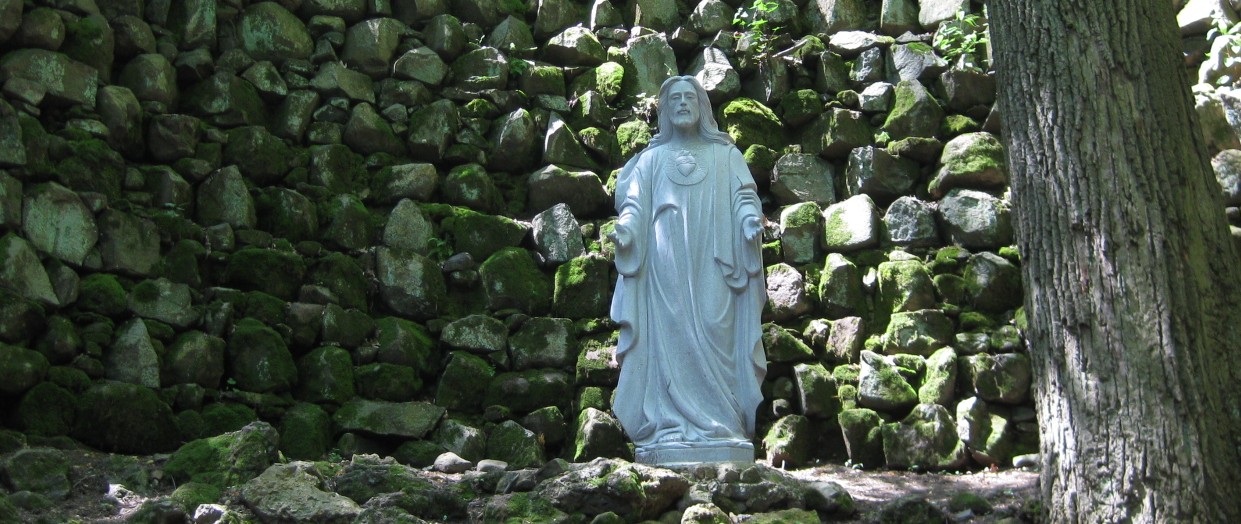 The grotto is a historically significant structure at Mount Manresa, the first permanent retreat house for laymen in the United States, founded on September 11, 1911. The structure of grotto was built in 1860, by previous estate owner, businessman Louis H . Meyer.
The grotto is a historically significant structure at Mount Manresa, the first permanent retreat house for laymen in the United States, founded on September 11, 1911. The structure of grotto was built in 1860, by previous estate owner, businessman Louis H . Meyer.
In 1912, the grotto became the home of a statue of the Sacred Heart of Jesus, which was donated to Mount Manresa. In 1913, on the second annual Lady’s Day, Father Provincial Anthony Maas, S.J., blessed the Sacred Heart Grotto.
In 1914 the NYT reported on the third annual reunion and reception of the Catholic’s Layman League for retreats and social studies at Mount Manresa, in which “Catholics present expressed their intention of boycotting the Panama –Pacific Exposition was passed unanimously.
The meeting was the largest that has been held since the retreats at Mount Manresa was purchased in 1911, and was held in the open air, the speakers taking their position in front of the shrine of the Sacred Heart, in a large stone grotto, near the retreat building. Some 2,000 laymen stood bareheaded on the steep decline, which sweeps down 100 feet before the grotto and on the level land beneath.” (see Article attached)
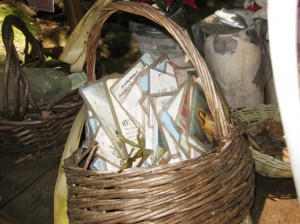 On September 11, 2001, The Shrine of the Sacred Heart became a place of comfort. Baskets placed in the grotto include mass cards of many who died during 9/11 with donations.
On September 11, 2001, The Shrine of the Sacred Heart became a place of comfort. Baskets placed in the grotto include mass cards of many who died during 9/11 with donations.
This location is very popular for retreat pictures as well as a place for contemplation. Over 15,000 people a year visited Mount Manresa. The Grotto is one of the major visits.
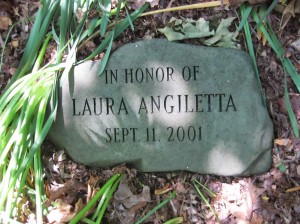 Mount Manresa Role in history in recovery after the September 11, 2001 Tragedy
Mount Manresa Role in history in recovery after the September 11, 2001 Tragedy
On its 90th anniversary Mount Manresa and its staff was heavily involved in the recovery after the tragedy of Sept 11, 2001, when 2,819 people were killed in the collapse of the World Trade Center.
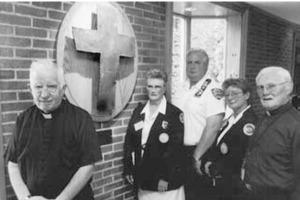 The staff were called to help those working at ground zero, at the Fresh Kills Landfill to bless the remains of the many victims who were found and to counsel workers. In appreciation of their efforts, Mount Manresa was presented with a cross made from the steel of what had been the World Trade Center.
The staff were called to help those working at ground zero, at the Fresh Kills Landfill to bless the remains of the many victims who were found and to counsel workers. In appreciation of their efforts, Mount Manresa was presented with a cross made from the steel of what had been the World Trade Center.
Many of the families of the victims return to Mount Manresa and offer prayers at the Sacred Heart Grotto and have purchased memorials to their lost family members.
History of the Grotto Dating back to 1860
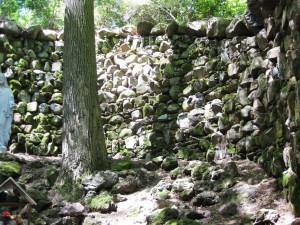 In the 1860’s Meyer built the grotto that came to be marked on many old maps as a bear den in the side of the hill.
In the 1860’s Meyer built the grotto that came to be marked on many old maps as a bear den in the side of the hill.
The grotto was built of iron ore carted there from Iron Hill (Todt Hill) on Staten Island. The cost of construction is not known, but it is confirmed that he spent $10,000 just to cart the rocks from Todt Hill. There was an underground stream that fed the fountain until it was diverted. The grotto was home to a statue of the Sacred Heart of Jesus, which was donated to Mount Manresa in 1912. It is a well known location and a very popular location for retreat pictures.
In addition to the historical value on the property of Mount Manresa, the grotto structure also has historical value related to Iron Hill of Staten Island.
According to The Minerals of New York by John H. Betts, “the NYC Parks Department reports the first evidence of iron mining on Staten Island dates to 1644 when Todt Hill was known by the Dutch as Yserberg, meaning Iron Hill, because of the widely disseminated iron oxides goethite-hematite that formed from the decomposition of the underlying serpentine. Large scale mining did not occur until around 1830 when modern blast furnaces initiated the growth in the cast iron industry.
In 1832 Walter Dongan granted permission to mine a portion of his property and mining continued in the area through 1880s, when the Lake Superior iron mines started producing iron ore more economically. An often cited statistic is that 300,000 tons of iron ore was mined on Staten Island, though the exact source of the statistic is unknown. The iron was mined for iron foundries and also finely ground for use as the pigment red ochre. Iron mining centered around Todt Hill, Emerson Hill and Grymes Hill.”
